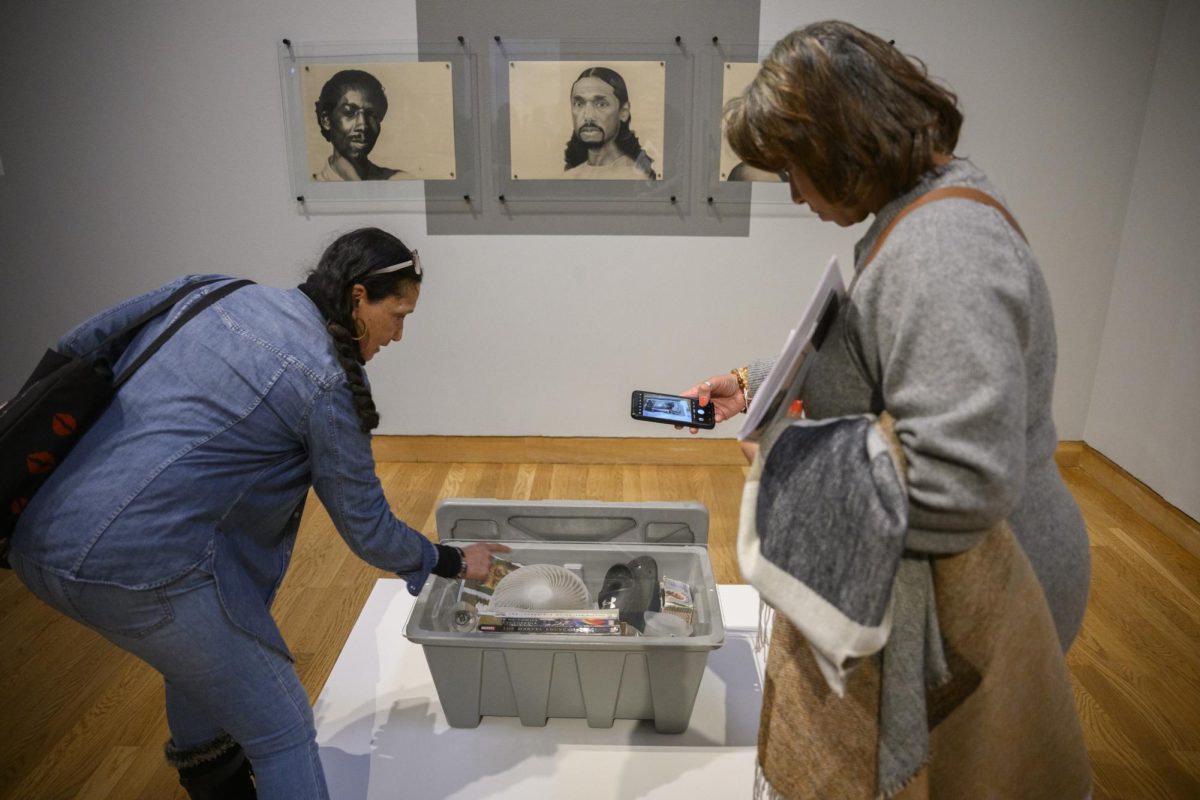The comments book poised on the gallery wall is plain and unassuming. But as local artist Ta-coumba Aiken opened it up and began reading aloud, a smile formed across his face.
“That’s what I’m talking about,” Aiken exclaimed as he peered down at the penned reactions of visitors to his new exhibition “Call and Response,” which opened at the Minneapolis Institute of Arts on Nov. 16.
Next to the book, Aiken had written “Tell me what you see” in a flowing black script. A black pen on a string hung nearby, inviting visitors to participate in the cyclical “Response” portion of “Call and Response.”
“It looks like fruit salad,” one heavy-handed ballpoint user claimed. “It looks like silly string,” suggested the clunky, crooked letters of a child’s hand. “I’m so horny!” was the only inked response out of a frisky, boyish font near the middle. Aiken chuckled.
Others saw memories of African motherland, of cosmological interconnectedness, of the spiritual realms that occupy the spaces between our bodies. And as Aiken engaged the pages of written tid-bits from friends, supporters, and strangers alike, it became obvious that he isn’t your usual – meaning disconnected and enigmatic – contemporary artist. He always positions his work in relation to his love for the community, both past and present.
Ta-coumba Aiken, a native of Evanston, Ill., and a Twin Cities community member since 1970, is a public artist, muralist and social activist. He founded the St. Paul Art Crawl, works extensively with mentoring programs for young artists, and offers up his art in the name of social activism. Although his art has been exhibited in many national and local museums and art galleries (Maya Angelou also owns one of his works), you are more likely to catch glimpses of his mosaic earthly stews while on your way to the corner store. He’s been commissioned to paint the sides of buses, grain elevators in Greater Minnesota and a municipal parking garage in St. Paul. To date, he’s created over 1000 works of public art.
In 1998, Aiken even had his art used for an Absolut Vodka advertisement, as part of the company’s expression of black artists campaign.
But with all the popularity Aiken has enjoyed, he said making a living as a public artist is still terribly hard – not to mention financially stressful. At the end of the day, folks still need to, as he claims, “buy my art” to put food on his dinner table. And public art in Minneapolis, according to Aiken, just doesn’t pay like the public art projects in places like New York.
Aiken’s artistic style is hard to forget. His mystical aesthetic consists of what he calls “rhythm patterns” and “spirit writing,” forming pulsating curvatures and celestial tangles of color within each work. Bodies wriggle among the outlines, their cheeks and lips and arms disappearing into different shapes upon a second glance. It’s folk art, but with a labyrinthine twist.
In “Spirit,” a large round canvas is splattered with geometric paint petals and carousel coloration. The “rhythm patterns” – repetitive black vines and facial expressions – shape an abstract rendering of bodies colliding, as if engaged in a frozen moment of Twister. It’s a precarious layering of corporeality, demanding of the viewer to unearth its notions of lineage, of ruptured histories, of both oppressed and liberated bodies.
The phantoms of the historical black experience are hard to separate from Aiken’s work, and although part of his creativity rests on a compulsion to relay the tales of disintegrated times, he hardly seems troubled by it.
“It’s like waking up from a nightmare and seeing that you have another day. Another chance. And that’s cool with me,” Aiken explains.
“Call and Response,” organized by the Minnesota Artists Exhibition Program, an artist-run curatorial department at the MIA, hand selected Aiken’s work out of a pool of promising local artists. And as Aiken wanders through the exhibit, greeting patrons and offering up anecdotes, his gratitude over his good fortune becomes obvious.
“My ancestors push me. I feel I have this A Team inside, telling me to apply,” he says of his decision to go for the exhibition opportunity.
And when Aiken shows his work, heads turn for a peek. In five years time, Aiken could very possibly blow up on the international art scene. But by all accounts, he continues to be the good-natured, compassionate people’s artist that the Twin Cities knows and loves him for.
Amid the starchy backdrop of the MIA walls, humidity-sensitive old codgers of premodern portraiture and walkie-talkie-sporting security guards, Aiken reaches out and begins rubbing the surface of his hand across a canvas – an almost unheard-of gesture inside a canonized curiosity cabinet like the MIA. But hey, he is the artist, after all. This is his time to shine.
The guard passing by says not a word.







